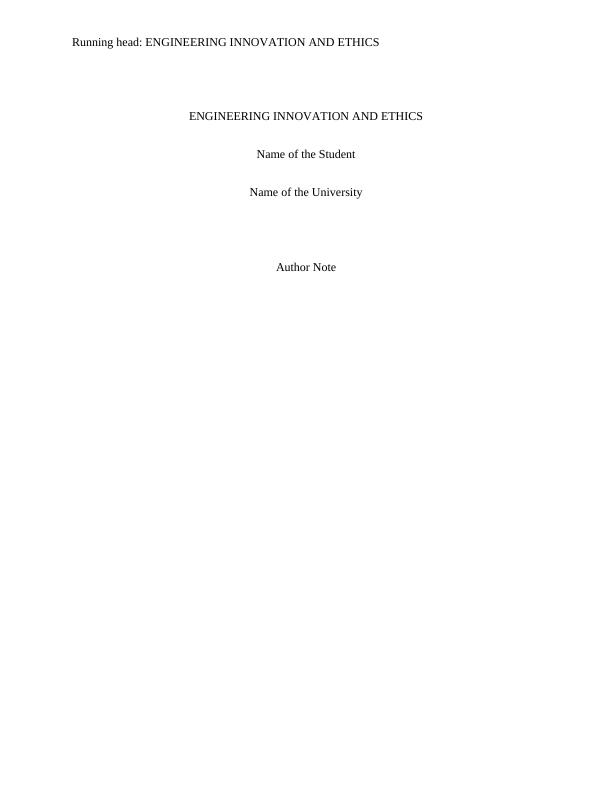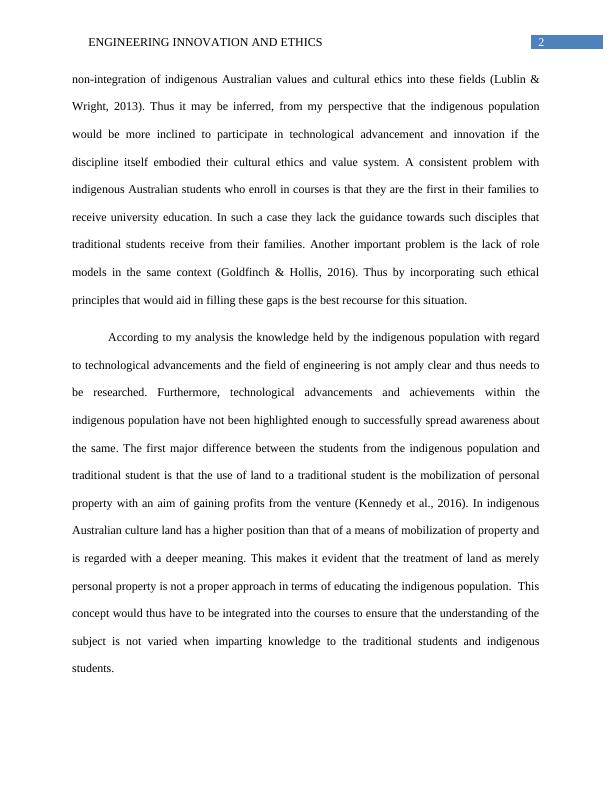Engineering Innovation and Ethics, Research Assignment
Added on 2021-05-31
8 Pages1710 Words24 Views
Running head: ENGINEERING INNOVATION AND ETHICS
ENGINEERING INNOVATION AND ETHICS
Name of the Student
Name of the University
Author Note
ENGINEERING INNOVATION AND ETHICS
Name of the Student
Name of the University
Author Note

1ENGINEERING INNOVATION AND ETHICS
Engineering Ethics in light of indigenous Australians
I have leant that in 1770 Captain James Cook drafted a map of the Australian Coast and
returned to England with results that favored colonization of Sydney (then known as botany bay)
(Roberts, 2013). In 1788 the first British fleet to commence colonization of Australia arrived in
Sydney and thus the colony of New South Wales was formed. Captain Arthur Philip was the
commanding officer for the expedition and the day is now commemorated as “Australia Day”
(Bashford, 2013). Australia then was used for convict settlements which was because criminals
with grave sentences were transported to Australia with the aim of ex-communicating them from
England. The native population of Australia was thus driven away from their natural homes and
forced to settle in parts that were yet to be colonized (Malaspinas et al., 2016). It is evident from
my personal experience that the indigenous population of Australia since then had seen a rapid
fall in density. However the treatment of the indigenous population has evolved into a more
ethical and humane approach and innovations in even the field of engineering makes ethical
considerations for the indigenous population. The following paragraphs will elaborate on these
consideration and the advantages ushered in by them in communicating with the indigenous
population.
In my opinion the social inclusion and social integration of Aboriginal or Torres Strait
inlanders have been attempted by the provision of subsidized education and welfare policies.
There are universities that would even provide scholarships for indigenous Australians who wish
to enroll in courses purely based on their domicile (Leigh et al., 2015). However, despite these
efforts indigenous Australian students seldom enroll for courses in fields such as technology and
innovation (Engineering). Research has shown that this could ideally be a consequence of the
Engineering Ethics in light of indigenous Australians
I have leant that in 1770 Captain James Cook drafted a map of the Australian Coast and
returned to England with results that favored colonization of Sydney (then known as botany bay)
(Roberts, 2013). In 1788 the first British fleet to commence colonization of Australia arrived in
Sydney and thus the colony of New South Wales was formed. Captain Arthur Philip was the
commanding officer for the expedition and the day is now commemorated as “Australia Day”
(Bashford, 2013). Australia then was used for convict settlements which was because criminals
with grave sentences were transported to Australia with the aim of ex-communicating them from
England. The native population of Australia was thus driven away from their natural homes and
forced to settle in parts that were yet to be colonized (Malaspinas et al., 2016). It is evident from
my personal experience that the indigenous population of Australia since then had seen a rapid
fall in density. However the treatment of the indigenous population has evolved into a more
ethical and humane approach and innovations in even the field of engineering makes ethical
considerations for the indigenous population. The following paragraphs will elaborate on these
consideration and the advantages ushered in by them in communicating with the indigenous
population.
In my opinion the social inclusion and social integration of Aboriginal or Torres Strait
inlanders have been attempted by the provision of subsidized education and welfare policies.
There are universities that would even provide scholarships for indigenous Australians who wish
to enroll in courses purely based on their domicile (Leigh et al., 2015). However, despite these
efforts indigenous Australian students seldom enroll for courses in fields such as technology and
innovation (Engineering). Research has shown that this could ideally be a consequence of the

2ENGINEERING INNOVATION AND ETHICS
non-integration of indigenous Australian values and cultural ethics into these fields (Lublin &
Wright, 2013). Thus it may be inferred, from my perspective that the indigenous population
would be more inclined to participate in technological advancement and innovation if the
discipline itself embodied their cultural ethics and value system. A consistent problem with
indigenous Australian students who enroll in courses is that they are the first in their families to
receive university education. In such a case they lack the guidance towards such disciples that
traditional students receive from their families. Another important problem is the lack of role
models in the same context (Goldfinch & Hollis, 2016). Thus by incorporating such ethical
principles that would aid in filling these gaps is the best recourse for this situation.
According to my analysis the knowledge held by the indigenous population with regard
to technological advancements and the field of engineering is not amply clear and thus needs to
be researched. Furthermore, technological advancements and achievements within the
indigenous population have not been highlighted enough to successfully spread awareness about
the same. The first major difference between the students from the indigenous population and
traditional student is that the use of land to a traditional student is the mobilization of personal
property with an aim of gaining profits from the venture (Kennedy et al., 2016). In indigenous
Australian culture land has a higher position than that of a means of mobilization of property and
is regarded with a deeper meaning. This makes it evident that the treatment of land as merely
personal property is not a proper approach in terms of educating the indigenous population. This
concept would thus have to be integrated into the courses to ensure that the understanding of the
subject is not varied when imparting knowledge to the traditional students and indigenous
students.
non-integration of indigenous Australian values and cultural ethics into these fields (Lublin &
Wright, 2013). Thus it may be inferred, from my perspective that the indigenous population
would be more inclined to participate in technological advancement and innovation if the
discipline itself embodied their cultural ethics and value system. A consistent problem with
indigenous Australian students who enroll in courses is that they are the first in their families to
receive university education. In such a case they lack the guidance towards such disciples that
traditional students receive from their families. Another important problem is the lack of role
models in the same context (Goldfinch & Hollis, 2016). Thus by incorporating such ethical
principles that would aid in filling these gaps is the best recourse for this situation.
According to my analysis the knowledge held by the indigenous population with regard
to technological advancements and the field of engineering is not amply clear and thus needs to
be researched. Furthermore, technological advancements and achievements within the
indigenous population have not been highlighted enough to successfully spread awareness about
the same. The first major difference between the students from the indigenous population and
traditional student is that the use of land to a traditional student is the mobilization of personal
property with an aim of gaining profits from the venture (Kennedy et al., 2016). In indigenous
Australian culture land has a higher position than that of a means of mobilization of property and
is regarded with a deeper meaning. This makes it evident that the treatment of land as merely
personal property is not a proper approach in terms of educating the indigenous population. This
concept would thus have to be integrated into the courses to ensure that the understanding of the
subject is not varied when imparting knowledge to the traditional students and indigenous
students.

End of preview
Want to access all the pages? Upload your documents or become a member.
Related Documents
Decolonization of Social Worklg...
|8
|1539
|21
Assignment on Nursing Professionlg...
|5
|1286
|80
Cultural Safety in Healthcarelg...
|8
|2356
|201
Engineering Innovation and Ethicslg...
|6
|1675
|91
Concept of Culture Competency: History and Culture of Indigenous Australianlg...
|5
|994
|468
Genuine Temporary Entrant (GTE) letter for ITlg...
|3
|644
|337
